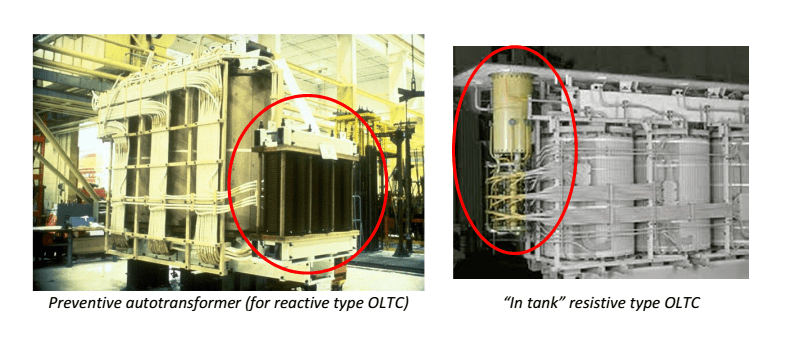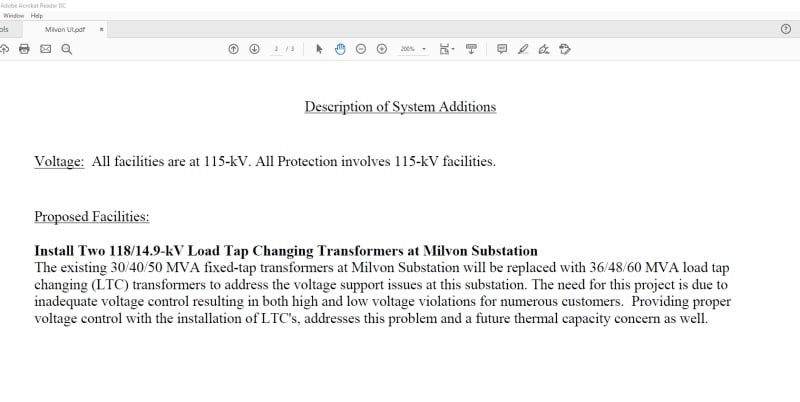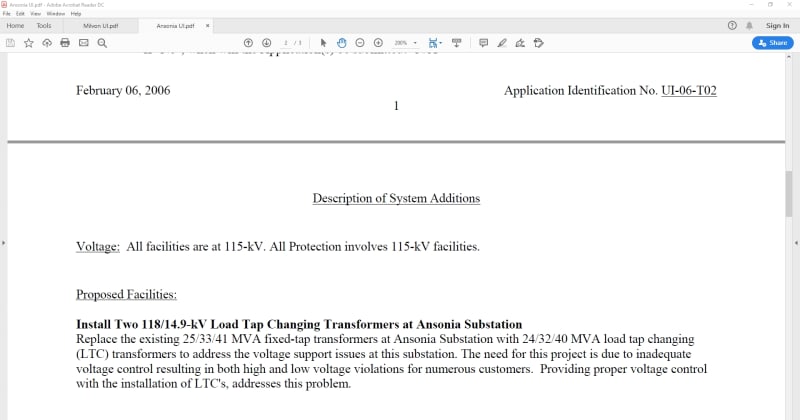Navigation
Install the app
How to install the app on iOS
Follow along with the video below to see how to install our site as a web app on your home screen.
Note: This feature may not be available in some browsers.
More options
Style variation
-
Congratulations TugboatEng on being selected by the Eng-Tips community for having the most helpful posts in the forums last week. Way to Go!
You are using an out of date browser. It may not display this or other websites correctly.
You should upgrade or use an alternative browser.
You should upgrade or use an alternative browser.
Tap Changer vs No Tap Changer 4
- Thread starter Mbrooke
- Start date
- Status
- Not open for further replies.
thermionic1
Electrical
I can't answer directly, but having an integral LTC can increase the risk of losing the entire unit in the event of a LTC failure. LTC failures are fairly high on the components of a transformer that can fail. There are some designs that have a Non LTC transformer connected to external voltage regulators. These regulators can be bypassed for maintenance and typically 3 single phase units are utilized. In the event of regulator maintenance or failure, the xfmr can still operate with the units bypassed. The regulators can be removed, repaired or replaced with much less effort than trying to work on an in situ LTC.
-
2
- #4
There is a weight and space saving for the whole transformer tank if you eliminate the OLTC.

Space its mostly saved for the total lenght of the tank (could go down to -20%), as you no longer need the preventive autotransformer if your OLCT is reactive type (like Reinhausen RMV), or the in-tank diverter switch - tap selector if its a resistive type OLTC.
And you also save the space and weight of the OLTC body itself if its external or "on-tank" (like RMV).

Space its mostly saved for the total lenght of the tank (could go down to -20%), as you no longer need the preventive autotransformer if your OLCT is reactive type (like Reinhausen RMV), or the in-tank diverter switch - tap selector if its a resistive type OLTC.
And you also save the space and weight of the OLTC body itself if its external or "on-tank" (like RMV).
- Thread starter
- #5
Let me stick to my earlier statement. Transformer weight is mainly in the core &coil. Contribution from tank and oil is rather small.Tank length will come down. But overall size is more decided by radiators mounted on tank.
The type of transformers that you mentioned-two winding stepdown units do require OLTC and not easy to eliminate from power quality angle. Since these units are normally YNyn, the OLTC will be at neutral end. OLTC failures are comparatively rare in such application and OLTC failure will not lead to disastrous consequences like fire as fault current will be limited by winding impedance.
We were discussing earlier in this forum about eliminating OLTC in EHV auto transformers like 400/220 kV where tap-changer is at line end and at 220 kV potential. Any deterioration in tap changer chamber oil will lead to a creep failure to ground with 220 kV system fault current discharging inside tank. This will result in explosion and fire from the huge volume of hot gases generated from oil.
In strong interconnected grids, EHV voltage will not change much and the tap changer will not be effective. This is the reason many utilities (eg Italy &Turkey) eliminated this type of line end OLTC in such auto-transformers with cost savings of nearly 20 % + reduced losses + slight reduction in size and weight. Any voltage variation will be taken care by the OLTC in down side two winding transformers to keep input voltage to distribution transformers under control.
The type of transformers that you mentioned-two winding stepdown units do require OLTC and not easy to eliminate from power quality angle. Since these units are normally YNyn, the OLTC will be at neutral end. OLTC failures are comparatively rare in such application and OLTC failure will not lead to disastrous consequences like fire as fault current will be limited by winding impedance.
We were discussing earlier in this forum about eliminating OLTC in EHV auto transformers like 400/220 kV where tap-changer is at line end and at 220 kV potential. Any deterioration in tap changer chamber oil will lead to a creep failure to ground with 220 kV system fault current discharging inside tank. This will result in explosion and fire from the huge volume of hot gases generated from oil.
In strong interconnected grids, EHV voltage will not change much and the tap changer will not be effective. This is the reason many utilities (eg Italy &Turkey) eliminated this type of line end OLTC in such auto-transformers with cost savings of nearly 20 % + reduced losses + slight reduction in size and weight. Any voltage variation will be taken care by the OLTC in down side two winding transformers to keep input voltage to distribution transformers under control.
- Thread starter
- #7
- Thread starter
- #9
Allow me to introduce these gems:
Palletjack
Electrical
MBrooke, Those aren’t for EHV.
That is the same regulators found in about every utility.
Personally I wouldn’t have an OLTC on our system. 40% of XF failures are with the OLTC. We have ONE that is due to come out this year. It’s a very old (40-50s era) transformer we have serving one mill.
Actually this unit still has two of the ORIGINAL U type bushings. First year productions..
That is the same regulators found in about every utility.
Personally I wouldn’t have an OLTC on our system. 40% of XF failures are with the OLTC. We have ONE that is due to come out this year. It’s a very old (40-50s era) transformer we have serving one mill.
Actually this unit still has two of the ORIGINAL U type bushings. First year productions..
- Thread starter
- #11
Palletjack
Electrical
True, but the post you were introducing those regulators to was talking about EHV.
I also feel quite sure prc knows about those regulators you “introduced” him to.
I know all about regulators and their placement, as I actually work in the utility industry.
I also feel quite sure prc knows about those regulators you “introduced” him to.
I know all about regulators and their placement, as I actually work in the utility industry.
- Thread starter
- #13
I should have quoted this, my mistake:
Two winding 115-13.8kv trafos do not require an OLTC. A feeder regulator is a legit substitute for an OLTC.
And in some cases (United Illuminating in Connecticut as one example) was able to get away without any voltage regulation for decades when the transmission system was lightly loaded and local generation was ample. In fact the West Haven Substation still doesn't have LTCs or any voltage regulation as I understand it (except a 115kv cap bank, if that counts ).
).


The type of transformers that you mentioned-two winding stepdown units do require OLTC and not easy to eliminate from power quality angle.
Two winding 115-13.8kv trafos do not require an OLTC. A feeder regulator is a legit substitute for an OLTC.
And in some cases (United Illuminating in Connecticut as one example) was able to get away without any voltage regulation for decades when the transmission system was lightly loaded and local generation was ample. In fact the West Haven Substation still doesn't have LTCs or any voltage regulation as I understand it (except a 115kv cap bank, if that counts


- Thread starter
- #14
Anyway, back on topic. @PalletJack- This: "40% of XF failures are with the OLTC" Most compelling reason to go for feeder regulation IMHO. Not to mention maintenance of the LTC. In addition line compensation can be set to tailor each individual feeder greatly improving the overall system voltage profile.
Palletjack
Electrical
I don’t dispute that. We are doing that now.
Our remaining bus regulated stations are put into work plans to change to feeder regulation, but this takes time, and we aren’t rich. We have to phase in gradually like so many others.
Our remaining bus regulated stations are put into work plans to change to feeder regulation, but this takes time, and we aren’t rich. We have to phase in gradually like so many others.
- Thread starter
- #16
I'm with prc on this one.
It could be an ANSI trend?, I've never seen voltage regulators used like that in my country (IEC based). Something similar is used in particular cases to boost overloaded distribution lines.
Just to understand it better: these voltage regulators are installed in every feeder right in the same substation the step-down transformer is located?
While could be the best technical solution for voltage control, it doesnt seem to be the most cost-effective for 20-80 MVA.
Also: I agree OLTC are one of the most critical component, but is the first time I hear the need to avoid them in this kind of application.
Very interesting thread.
It could be an ANSI trend?, I've never seen voltage regulators used like that in my country (IEC based). Something similar is used in particular cases to boost overloaded distribution lines.
Just to understand it better: these voltage regulators are installed in every feeder right in the same substation the step-down transformer is located?
While could be the best technical solution for voltage control, it doesnt seem to be the most cost-effective for 20-80 MVA.
Also: I agree OLTC are one of the most critical component, but is the first time I hear the need to avoid them in this kind of application.
Very interesting thread.
Several utilities in the opted to use three single-phase transformer voltage regulator per feeder. The original driver back in the 1950s & 1960s was associated with the concern of poor reliability of the Conventional On-load-tap-changer (OLTC) have moving parts and historically is one of the weakest points in the transformer.
Although there is more flexibility to repair and replace the voltage regulator transformer in each distribution feeder, this option is not cheap since requires additional space, foundation, installation, and O&M capital budget. Recently one of the utilities that we work for is concerned with the potential leak of oil and associated liability and environmental compliance on a large amount of single-phase regulating transformers.
The good news today is that there are promising options commercially available with a new vacuum OLTC design in the market that show promising expectancy to improve the transformer reliability.
NOTE: The enclosed thread and the video could supplement some of the issues in this discussion
Although there is more flexibility to repair and replace the voltage regulator transformer in each distribution feeder, this option is not cheap since requires additional space, foundation, installation, and O&M capital budget. Recently one of the utilities that we work for is concerned with the potential leak of oil and associated liability and environmental compliance on a large amount of single-phase regulating transformers.
The good news today is that there are promising options commercially available with a new vacuum OLTC design in the market that show promising expectancy to improve the transformer reliability.
NOTE: The enclosed thread and the video could supplement some of the issues in this discussion
Palletjack
Electrical
Once you start getting above 20-25 MVA I can see the full range regulators getting extremely heavy, expensive, and not really an option. Even limiting them to 5% your still not going to get over the 35MVA 100% loading.
Once you get that big maintenance and machinery to change them out becomes a problem.
Especially with some of the older station designs where the bus is built over the regulators rather than the bus coming into and leaving the regulators from behind them.
Once you get that big maintenance and machinery to change them out becomes a problem.
Especially with some of the older station designs where the bus is built over the regulators rather than the bus coming into and leaving the regulators from behind them.
- Thread starter
- #20
- Status
- Not open for further replies.
Similar threads
- Locked
- Question
- Replies
- 6
- Views
- 1K
- Locked
- Question
- Replies
- 18
- Views
- 1K
- Question
- Replies
- 1
- Views
- 3K
- Question
- Replies
- 1
- Views
- 810
